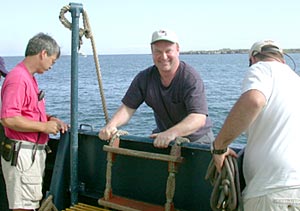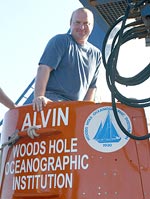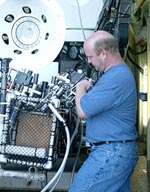|
Interviews: Co-Chief
Scientist Tim Shank
 Tim
climbs aboard RV Atlantis in Puerto Ayora, Santa Cruz Island
for his first cruise as Co-Chief Scientist. Tim
climbs aboard RV Atlantis in Puerto Ayora, Santa Cruz Island
for his first cruise as Co-Chief Scientist.
Question:
Do you remember your first dive in Alvin?
Tim:
You never forget your first dive. December 15, 1993. With Dan Fornari
and Pat Hickey. Dive No. 2683. You don’t forget.
 |
 |
| Tim
enters Alvin for the first dive to the Galapágos
Rift in 12 years. |
Question:
Where did you dive?
Tim:
9° 50’N on the East Pacific Rise. In 1991, just before
I signed on as a graduate student, Rich Lutz, Dan Fornari, and Rachel
Haymon had found that volcanic activity at the 9° 50’N
vent site had just wiped out a thriving community of vent animals.
It was the undersea equivalent of studying what happened after Mount
St. Helens erupted and wiped out the landscape around it. Here was
a rare opportunity to start at the very beginning, when there was
virtually no life left, and see what would happen and how it would
happen.
Question:
What was the plan for studying this area?
Tim:
We set aside an area to study—1 1/2 kilometers long by 100
meters wide. With Alvin, we put out 200 markers, like guideposts,
throughout the area, so we could tell where we were each time we
returned in Alvin, and we took lots and lots of video of
the area. My first assignment for Lutz, my graduate advisor, was
to study those videos. He said, “You need to know this area
of seafloor like the back of your hand.” I watched those videos
over and over and over again. It was like the movie “Groundhog
Day.” Eventually, I knew where every single rock was in that
area. I studied that area for a year and a half before I ever saw
it in person on my first dive in Alvin.
Question:
What did the site look like in 1991 right after the eruption?
Tim:
Utter devastation. All the animals were dead. Some were obliterated.
Photographs showed only white bacterial debris covering the seafloor.
It was like a snowscape. But by 1992, the video showed that a small,
accordion-shaped tubeworm called Tevnia jerichonana had returned
to colonize about 17 different sites at 9°N. In 1993 when I
dived, we didn’t know what we would find. Maybe these sites
were all dead. Maybe they were the same as the year before. Maybe
other animals might have come in.
Question:
OK, OK, we can’t stand it anymore. What did you see on your
first dive?
Tim:
So I went down. Remember, I had studied this area intensely for
a year and a half. It was like seeing old photos of a place that
you heard about as a kid, and then growing up and finally getting
to see it in real life. And it was more than I could ever have hoped
for. Just about every one of those 17 little areas of Tevnia
were covered with much larger tubeworms, Riftia pachyptila. The areas had just blossomed into bright, white and red, pristine
bouquets of tubeworms. Boom. It was so dramatic. I was so excited.
I kept on saying things like, “Wow, see that spot. It was this
way before, and now it’s like this.” Meanwhile, Dan, a
geologist, was reporting on all the rock formations, and the scientists
on the surface ship were asking, “What about the biology? What
about the biology?” And Dan said, almost incidentally, “The
biology? Oh, it’s packed with animals.”
Question:
Your specialty is studying the animals, right?
Tim:
We have been presented with a completely new ecosystem on our planet.
We are trying to figure out how that ecosystem works, and how all
the species in it interact with each other. All the animals are
down there on the tabletop of the seafloor—sometimes piled
up together like people in a tenement, five to a bedroom. And there’s
no way we have seen everything there is to see. For scientists,
hydrothermal vents are like a dreamland, with only one problem—it’s
a mile and a half under water and you can’t touch your animals.
Inaccessibility is the cruel joke God plays on us.
 |
 |
| Tim
checks the placement and accessibility of equipment in Alvin’s
basket before he makes a dive. |
Question:
So a dive in Alvin is not exactly like a typical day in the
office.
Tim:
When you’re on the seafloor, you’re working. You’re
funded by the American public and you have a mission to do. So I’d
say 90 percent of me is focused on that mission.
But perhaps 10 percent of me is aware that everything I’m seeing
has some element of mystery and discovery to it. You’re looking
at an animal or an animal community that you know so little about
and that you want to know so much about. Life is still a fundamental
mystery. There’s still something divine about studying life
that makes it fascinating and compelling to me. People always ask
me what it’s like to be at the bottom of the ocean. It’s
like trying to describe a beautiful sunset to someone. You can’t
really do it with words. Even if two people are sitting next to
each other, watching the same sunset, it’s very personal, and
each person experiences it in his or her own way.
QUESTION:
How many times have you dived in Alvin?
Tim:
I’ve had about 35 dives in Alvin, to many different
mid-ocean ridges in different oceans. You probably can count the
number of people who have done that on the fingers of two hands.
So I am very fortunate. But until today (May 26, 2002) I’ve
never dived on the Galápagos Rift, where this whole line
of research began. |

 Tim
climbs aboard RV Atlantis in Puerto Ayora, Santa Cruz Island
for his first cruise as Co-Chief Scientist.
Tim
climbs aboard RV Atlantis in Puerto Ayora, Santa Cruz Island
for his first cruise as Co-Chief Scientist.
